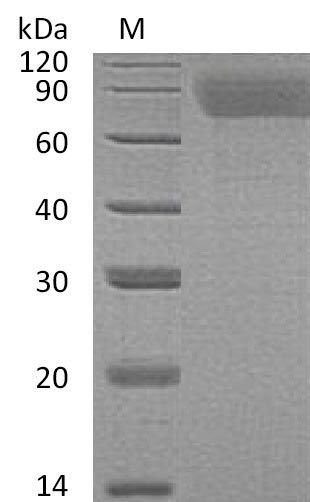Recombinant Human Thrombopoietin (THPO) is produced in a mammalian cell expression system, which appears to ensure proper folding and post-translational modifications. This full-length mature protein spans amino acids 22 to 353 and carries a 6xHis tag at both ends. The purity exceeds 95% based on SDS-PAGE verification, and it shows biological activity with an ED50 of 0.55 ng/ml in cell proliferation assays using MO7E cells. Endotoxin levels stay below 1.0 EU/µg, as measured by the LAL method.
Thrombopoietin (THPO) serves as a key growth factor that regulates platelet production. It's central to hematopoiesis—specifically in how megakaryocytes proliferate and differentiate. These are the progenitor cells that generate platelets. Understanding THPO may help researchers grasp disorders affecting platelet counts, like thrombocytopenia and thrombocythemia. This makes it valuable for hematological research.
Potential Applications
Note: The applications listed below are based on what we know about this protein's biological functions, published research, and experience from experts in the field. However, we haven't fully tested all of these applications ourselves yet. We'd recommend running some preliminary tests first to make sure they work for your specific research goals.
1. Megakaryocyte Differentiation and Platelet Production Studies
This recombinant THPO is confirmed to be highly bioactive (ED₅₀ 0.55 ng/ml in MO7E cells) and suitable for megakaryocyte studies. However, the dual His-tags (N and C-terminal) may sterically hinder receptor binding as both termini are involved in MPL receptor engagement. While mammalian expression ensures proper glycosylation, researchers should validate that differentiation kinetics and platelet production match tag-free THPO, particularly for long-term cultures where tag effects may accumulate.
2. Cell Proliferation and Viability Assays
The protein is appropriate for proliferation assays, but the dual tagging may alter potency compared to native THPO. The high purity supports consistency, but researchers should include tag-free THPO controls to ensure proliferation kinetics and dose-response curves reflect physiological signaling. The mammalian glycosylation is advantageous, but the tags may affect signal duration or amplitude in sensitive assays.
3. Protein-Protein Interaction Studies
The dual His-tags facilitate pull-down assays but may cause steric interference with binding partners near the termini. While mammalian folding supports authentic interactions, the tags might block binding sites or alter conformation. Researchers should validate novel interactions with tag-free THPO and include stringent controls (e.g., tag-only) to distinguish specific from non-specific binding.
4. Antibody Development and Validation
This THPO serves as an antigen, but antibodies may predominantly target terminal epitopes masked by tags in native THPO. The dual tags could generate antibodies with poor affinity for native protein termini. Comprehensive validation should use tag-free, mammalian-expressed THPO to ensure antibodies recognize physiological epitopes not obscured by tags.
5. Signal Transduction Pathway Analysis
The protein is suitable for signaling studies, but the tags may alter the kinetics of MPL receptor dimerization/activation. Researchers should confirm that JAK-STAT and PI3K/AKT pathway activation dynamics (especially phosphorylation duration) match tag-free THPO. The low endotoxin is beneficial, but signaling amplitude may be affected by tag-induced steric constraints.
Final Recommendation & Action Plan
This mammalian-expressed human THPO with dual His-tags is bioactive but requires careful validation due to potential steric effects from both N- and C-terminal tags. For immediate use: 1) In functional assays (proliferation/differentiation), employ low concentrations (0.1-1 ng/ml) but include tag-free THPO controls to verify physiological relevance; 2) For interaction studies, the tags are useful for purification but may require cleavage for binding assays involving terminal domains; 3) When developing antibodies, use this protein for immunization but screen against tag-free THPO to avoid tag-dominated immune responses; 4) For signaling studies, the mammalian glycosylation is ideal but validate early signaling events (first 5-30 min) against tag-free protein to detect tag-related kinetic alterations. Always include controls accounting for tag-induced artifacts, and consider tag cleavage for critical applications involving receptor binding or structural studies. While the demonstrated bioactivity confirms functionality, the dual tagging necessitates extra validation steps compared to singly-tagged or tag-free variants.






